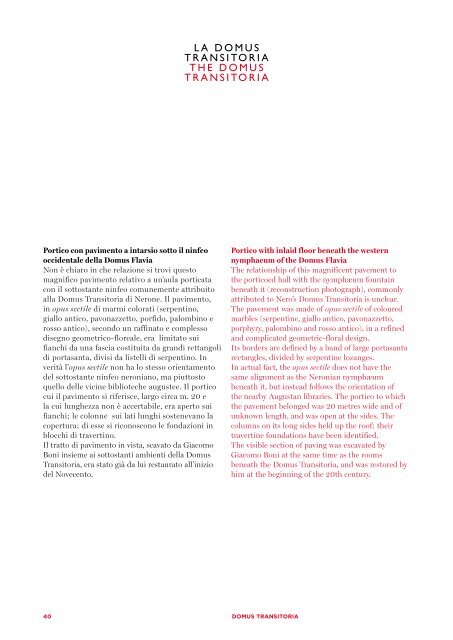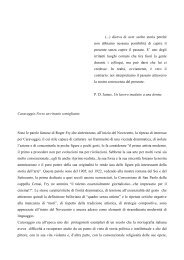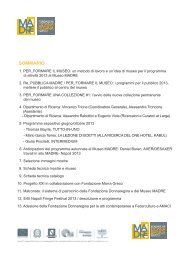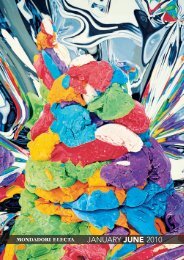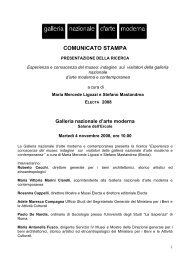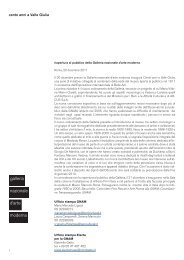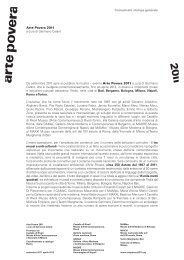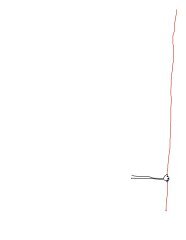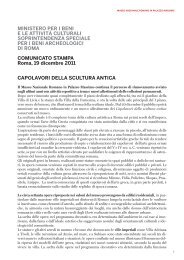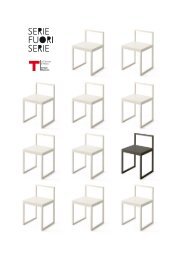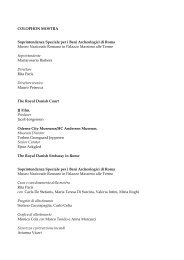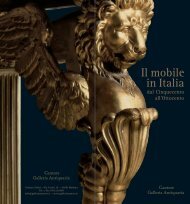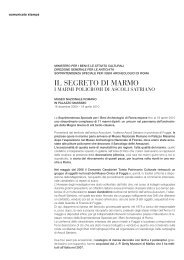You also want an ePaper? Increase the reach of your titles
YUMPU automatically turns print PDFs into web optimized ePapers that Google loves.
Portico con pavimento a intarsio sotto il ninfeo<br />
occidentale della Domus Flavia<br />
Non è chiaro in che relazione si trovi questo<br />
magnifico pavimento relativo a un’aula porticata<br />
con il sottostante ninfeo comunemente attribuito<br />
alla Domus Transitoria di <strong>Nerone</strong>. Il pavimento,<br />
in opus sectile di marmi colorati (serpentino,<br />
giallo antico, pavonazzetto, porfido, palombino e<br />
rosso antico), secondo un raffinato e complesso<br />
disegno geometrico-floreale, era limitato sui<br />
fianchi da una fascia costituita da grandi rettangoli<br />
di portasanta, divisi da listelli di serpentino. In<br />
verità l’opus sectile non ha lo stesso orientamento<br />
del sottostante ninfeo neroniano, ma piuttosto<br />
quello delle vicine biblioteche augustee. Il portico<br />
cui il pavimento si riferisce, largo circa m. 20 e<br />
la cui lunghezza non è accertabile, era aperto sui<br />
fianchi; le colonne sui lati lunghi sostenevano la<br />
copertura; di esse si riconoscono le fondazioni in<br />
blocchi di travertino.<br />
Il tratto di pavimento in vista, scavato da Giacomo<br />
Boni insieme ai sottostanti ambienti della Domus<br />
Transitoria, era stato già da lui restaurato all’inizio<br />
del Novecento.<br />
L A D O M U S<br />
T R A N S I TO R I A<br />
T H E D O M U S<br />
T R A N S I TO R I A<br />
40 DOMUS TRANSITORIA<br />
Portico with inlaid floor beneath the western<br />
nymphaeum of the Domus Flavia<br />
The relationship of this magnificent pavement to<br />
the porticoed hall with the nymphæum fountain<br />
beneath it (reconstruction photograph), commonly<br />
attributed to Nero’s Domus Transitoria is unclear.<br />
The pavement was made of opus sectile of coloured<br />
marbles (serpentine, giallo antico, pavonazzetto,<br />
porphyry, palombino and rosso antico), in a refined<br />
and complicated geometric-floral design.<br />
Its borders are defined by a band of large portasanta<br />
rectangles, divided by serpentine lozanges.<br />
In actual fact, the opus sectile does not have the<br />
same alignment as the Neronian nymphæum<br />
beneath it, but instead follows the orientation of<br />
the nearby Augustan libraries. The portico to which<br />
the pavement belonged was 20 metres wide and of<br />
unknown length, and was open at the sides. The<br />
columns on its long sides held up the roof; their<br />
travertine foundations have been identified.<br />
The visible section of paving was excavated by<br />
Giacomo Boni at the same time as the rooms<br />
beneath the Domus Transitoria, and was restored by<br />
him at the beginning of the 20th century.


